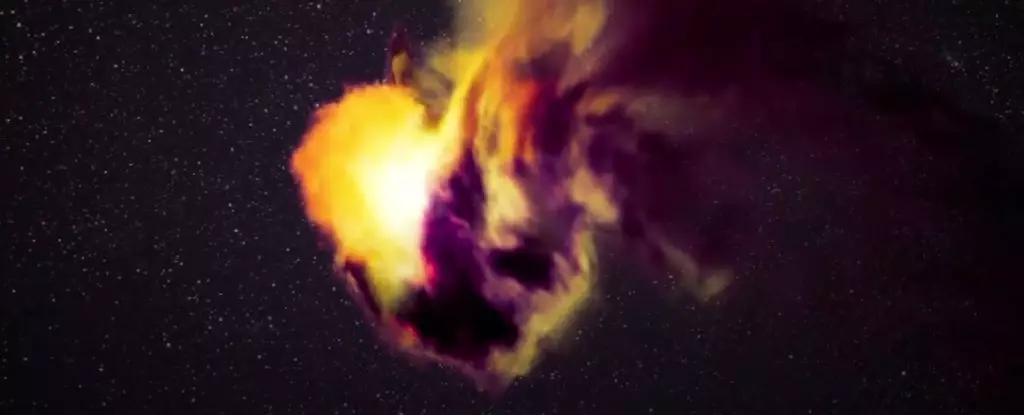In the vast expanse of the universe, few cosmic phenomena evoke as much awe and intrigue as supernovae—catastrophic explosions marking the end of a massive star’s life. Yet, the event observed in 2021, designated SN2021yfj, stands apart, compelling astrophysicists to rethink long-held theories about stellar death. Unlike typical supernovae, which predominantly reveal lighter elements like hydrogen and helium, this explosion displayed a rich tapestry of heavier elements, including silicon, sulfur, and argon—a discovery that provokes more questions than answers.
This extraordinary supernova, situated a staggering 2.2 billion light-years away, is not just a spectacular cosmic light show; it’s a window into the complex internal workings of dying stars. The detection of these heavier elements directly challenges the classical “onion-layer” model of stellar interiors, where lighter elements reside on the outside and heavier ones are buried closer to the core. Instead, SN2021yfj indicates a collapse and ejection process far more turbulent and chaotic than previously imagined, exposing layers of the star’s inner composition in a way that no simulation has fully predicted.
Rethinking Stellar Structure and Evolution
Traditional astrophysical models posit that stars generate energy by fusion in their cores, gradually building up layers of heavier elements—hydrogen to helium, then to carbon, oxygen, and ultimately up to iron—before they reach their explosive endpoints. In this paradigm, when the star finally detonates, it primarily releases lighter remnants, with the explosive debris mostly consisting of the elements fusing near the star’s surface.
However, the unconventional findings from SN2021yfj imply that some stars may undergo a far more destructive prelude—losing considerable portions of their outer layers or even being stripped entirely before the supernova occurs. This mass loss is suspected to be not just a gentle shedding but an explosive shedding involving multiple episodes of violent ejections. These tumultuous processes could leave the star nearly bare, exposing the heavier inner layers—something that conventional models had only theorized as a possibility in extreme conditions but never conclusively observed.
Astrophysicists are now grappling with the reality that stellar evolution might include more exotic pathways. Instead of a straightforward progression towards supernova, some massive stars could experience a series of eruptive phases, each stripping away parts of their mass and radically altering the dynamics of the impending explosion. This new perspective widens the spectrum of stellar death and challenges the assumption that supernovae are predominantly uniform events governed by well-understood core processes.
Implications for Supernova Mechanics and Elemental Enrichment
One of the most striking aspects of SN2021yfj is the evident presence of heavy elements such as silicon, sulfur, and argon close to the core at the time of explosion. Because these elements are crucial to understanding the lifecycle of stars, their detection in the ejecta suggests that the star’s internal stratification was significantly disturbed before the explosion. The fact that the star may have been predominantly “stripped to the bone” implies an intense, turbulent death that pushes the boundaries of current astrophysical theories.
This revelation is not just about refining models of stellar interiors; it also profoundly impacts our understanding of cosmic chemical enrichment. Supernovae are the universe’s forges, dispersing heavy elements into space, seeding future generations of stars, planets, and even life. If some stars can shed their outer layers so thoroughly before exploding, the distribution of elements across galaxies could be more varied and complex than previously thought. This could influence models of galactic evolution, the formation of elements, and the origins of life-essential materials.
The process by which such a star could lose mass so drastically—likely through multiple explosive episodes—raises questions about the stability of massive stars nearing death. Whether through intense pulsations, magnetic instabilities, or fallback phenomena remains uncertain. Nonetheless, SN2021yfj embodies a more violent and chaotic endgame—one where layers of the star are torn away and propelled into space in rapid succession, only for the final explosion to catch up with and collide against the previously expelled shells. This collision would intensify the luminosity and alter the composition of the resulting supernova remnant, making it an even more powerful and exotic cosmic event.
Challenging Assumptions and Embracing Cosmic Uncertainty
While current hypotheses present a compelling narrative, the scientific community rightly remains cautious. The rarity of such observations means we are still in the early stages of understanding the full complexity of these phenomena. Each supernova holds clues, but the particular case of SN2021yfj underscores just how diverse and unpredictable stellar deaths can be.
The event’s peculiarities suggest that our existing models, although robust, are incomplete. They often overlook the potential for massive stars to undergo radical structural transformations just before their demise. Whether through particle-driven eruptions, unstable nuclear burning phases, or unknown instabilities, the universe prompts us to accept that its processes are more intricate than our simplified timber explanations. It’s a humbling reminder that nature constantly exceeds human expectations, urging us to refine our theories and expand our horizons.
Looking ahead, astronomers will need to gather more data, observe additional supernovae with similar characteristics, and perhaps develop entirely new frameworks to explain these extreme stellar finales. Only with a broader, more nuanced understanding can we truly appreciate how the universe operates on its most violent and mysterious edges. SN2021yfj stands as a testament to the universe’s ability to surprise and inspire, igniting a new chapter of inquiry into the final acts of massive stars.

